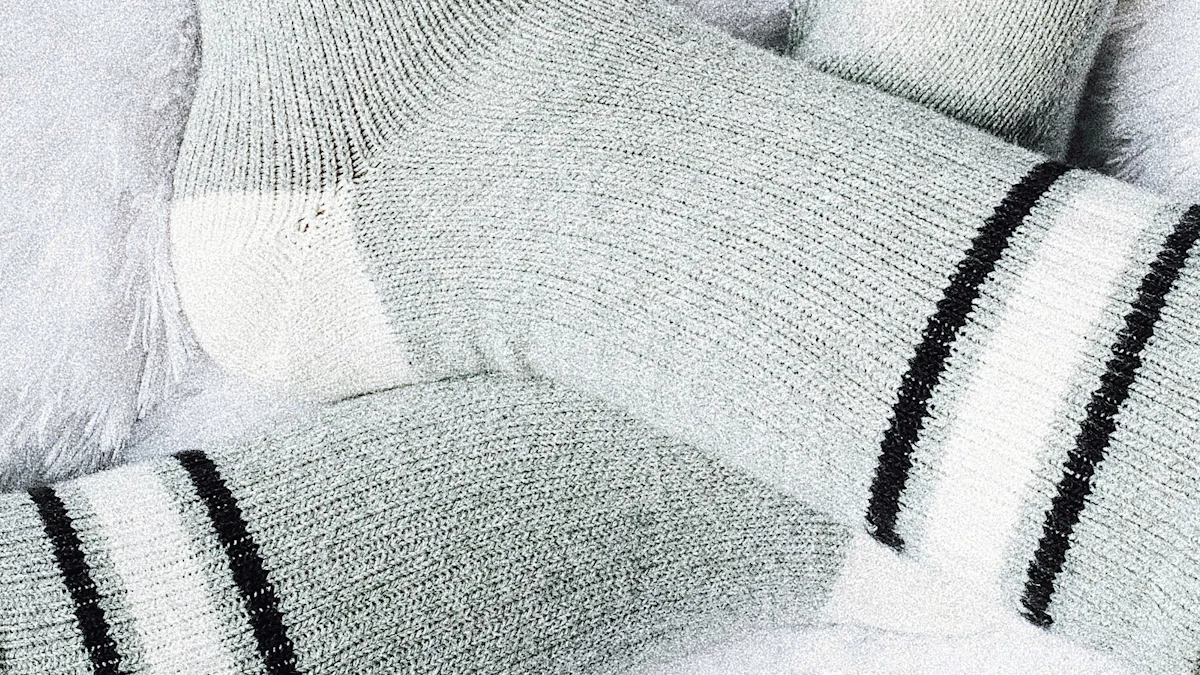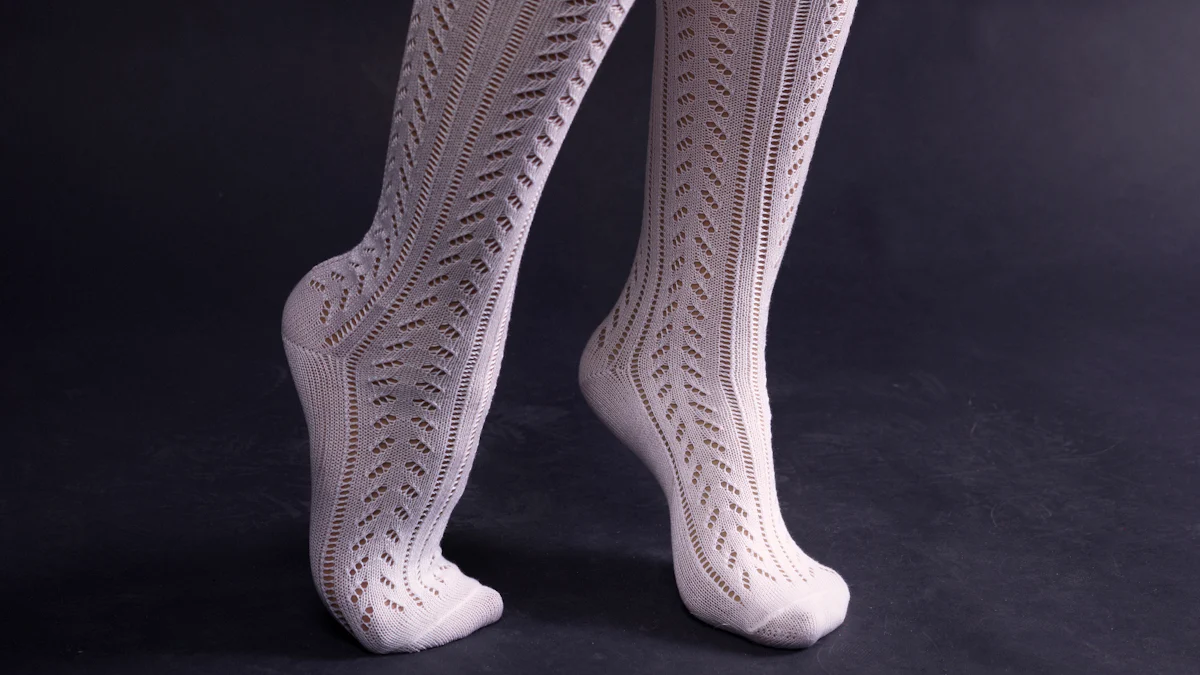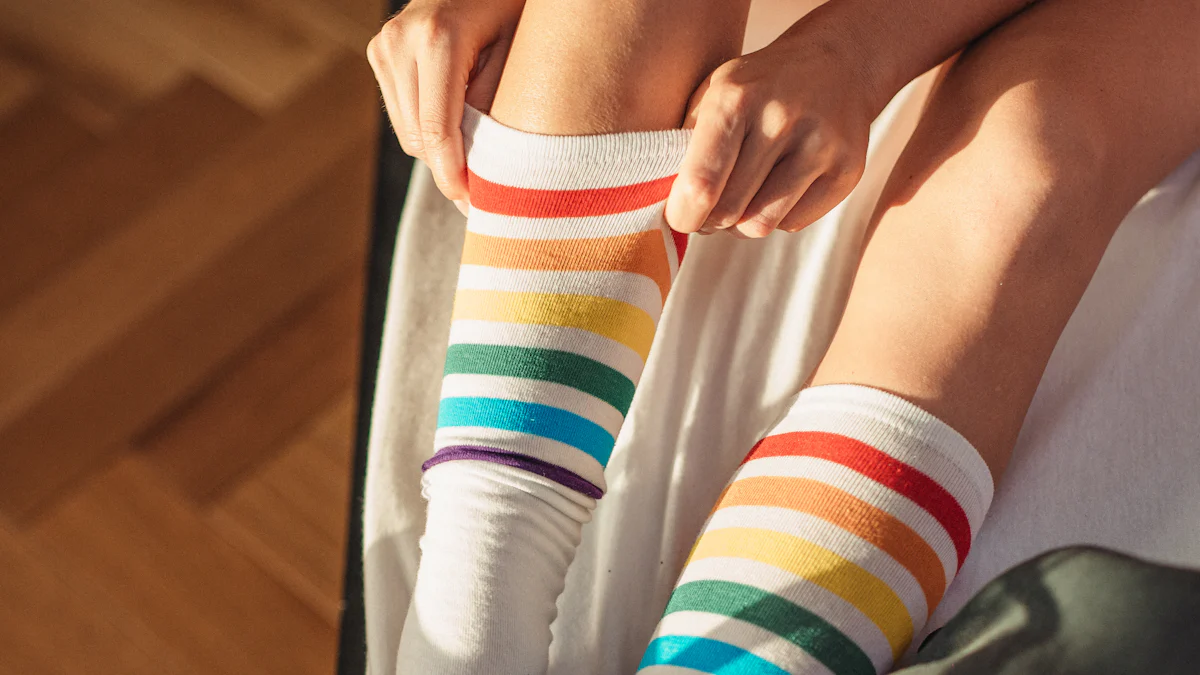
Tube socks have become a staple in both fashion and daily wear. These versatile socks, known for their long, cylindrical shape, have graced the feet of athletes and fashion enthusiasts alike. The journey of the tube sock offers a fascinating glimpse into how a simple piece of clothing can evolve and leave a lasting impact on culture and style.
Origins of Tube Socks

Early History
Ancient Footwear
Humans have wrapped their feet in various materials for thousands of years. The oldest known socks date back to around 5000 BCE. These early foot coverings were likely made from animal skins. Romans often wrapped their feet in strips of leather or woven fabric. This practice marked the early emergence of socks.
Greek poet Hesiod mentioned socks in his poem “Works and Days” around 800 BC. He referred to them as ‘piloi’. Romans later began sewing fitted socks called ‘udones’. These early forms of socks laid the groundwork for future innovations.
Emergence of Socks
The concept of socks evolved over centuries. Early socks were simple and functional. They provided warmth and protection. As societies advanced, so did sock-making techniques. By the Middle Ages, knitted socks became more common. These socks offered better fit and comfort.
Knitting machines revolutionized sock production in the 16th century. This innovation allowed for mass production. Socks became more accessible to the general population. The stage was set for the invention of the tube sock.
Invention of Tube Socks
Technological Innovations
The tube sock emerged as a result of technological advancements. The Nelson Knitting Company of Rockford, Illinois, invented the tube sock in 1967. This invention marked a significant milestone. Tube socks featured a long, cylindrical shape without a defined heel. This design made them versatile and easy to produce.
Machine knitting played a crucial role in the development of tube socks. This technology enabled the production of seamless socks. The absence of a heel allowed for a one-size-fits-all approach. Tube socks quickly gained popularity due to their practicality.
Early Manufacturers
The Nelson Knitting Company led the way in tube sock production. Other manufacturers soon followed suit. The simplicity of the tube sock design appealed to many. Athletes and everyday consumers embraced tube socks.
Tube socks became a staple in sports and casual wear. Their durability and comfort made them a favorite choice. The rise of athletic culture in the late 20th century further boosted their popularity. Tube socks became synonymous with sports and leisure activities.
Tube Socks in the 20th Century
Post-War Popularity
Sports Influence
Athletes embraced tube socks after World War II. Basketball players wore tube socks for their comfort and support. The long, cylindrical shape provided better coverage. Tube socks became a staple in sports uniforms. Football and soccer players also adopted tube socks. The versatility of tube socks made them ideal for various sports.
The rise of fitness culture in the 1970s boosted tube socks’ popularity. Joggers and gym-goers preferred tube socks for their practicality. The tube sock’s design allowed for easy movement. Athletes appreciated the durability and comfort of tube socks. The sports world played a significant role in popularizing tube socks.
Cultural Impact
Tube socks transcended sports and entered mainstream culture. Movies and TV shows featured characters wearing tube socks. The vibrant colors and bold stripes caught the public’s eye. Tube socks became a symbol of casual and athletic lifestyles. Celebrities and musicians also embraced tube socks. The fashion world took notice of the tube sock trend.
Nostalgia played a role in the tube sock’s cultural impact. People associated tube socks with simpler times. The tube sock’s retro appeal attracted new generations. Vintage tube socks became sought-after items. The cultural significance of tube socks continued to grow.
Fashion Trends
1970s and 1980s
The 1970s disco era embraced tube socks with colorful stripes. Tube socks complemented the flashy outfits of the time. Roller skaters and dancers wore tube socks as part of their attire. The tube sock’s bold patterns matched the vibrant fashion trends. Tube socks became a staple in casual wear during this period.
The 1980s saw tube socks evolve into a fashion statement. Fitness culture influenced tube sock designs. Neon colors and logos adorned tube socks. Tube socks became synonymous with the aerobics craze. The tube sock’s versatility made it a popular choice for various outfits. Tube socks remained a favorite accessory throughout the decade.
Iconic Moments
Tube socks had several iconic moments in pop culture. Michael Jackson famously wore white tube socks with his loafers. The look became an iconic part of his style. Movies like “Rocky” and “The Breakfast Club” featured characters in tube socks. These appearances cemented tube socks’ place in fashion history.
Sports events also highlighted tube socks. Olympic athletes wore tube socks during competitions. The tube sock’s presence on the global stage boosted its popularity. Tube socks became a symbol of athletic excellence. The tube sock’s journey through the 20th century left a lasting impact on fashion and culture.
Modern Era of Tube Socks

Technological Advancements
Material Innovations
The modern era has seen significant advancements in tube sock materials. Manufacturers now use high-performance fabrics that offer moisture-wicking properties. These materials keep feet dry and comfortable. Athletes benefit from these innovations during intense physical activities.
Compression socks have also gained popularity. These socks improve blood circulation and reduce muscle fatigue. Many tube socks now incorporate compression technology. This feature enhances athletic performance and recovery.
Waterproof socks represent another material innovation. These socks protect feet from wet conditions. Outdoor enthusiasts appreciate the functionality of waterproof tube socks. Hiking and camping become more enjoyable with dry feet.
Design Improvements
Design improvements have transformed tube socks into stylish accessories. Seamless construction eliminates discomfort from rubbing or chafing. This feature enhances the overall wearing experience. Tube socks now come in various lengths to suit different preferences.
Manufacturers have introduced arch support in tube socks. This design element provides better foot stability. Athletes and casual wearers alike benefit from this added support.
Customization options have also expanded. Consumers can choose tube socks with unique patterns and colors. Personalized designs make tube socks a fashion statement. The combination of comfort and style appeals to a wide audience.
Current Fashion Trends
Celebrity Influence
Celebrities have played a significant role in popularizing tube socks. Fashion icons often sport tube socks in their casual outfits. This trend has influenced fans to adopt similar styles.
Musicians and actors frequently showcase tube socks in music videos and movies. These appearances boost the visibility of tube socks in popular culture. Social media platforms amplify this influence. Followers emulate their favorite celebrities’ fashion choices.
Tube socks have become a staple in streetwear culture. Influencers and fashion bloggers highlight tube socks in their posts. The versatility of tube socks makes them a popular accessory.
Streetwear and High Fashion
Streetwear brands have embraced tube socks as a key element. Bold designs and logos adorn many tube socks. These socks complement urban fashion trends. Sneakers and tube socks create a classic streetwear look.
High fashion designers have also incorporated tube socks into their collections. Runway shows feature models wearing tube socks with high-end outfits. This fusion of casual and luxury styles appeals to fashion-forward individuals.
Collaborations between designers and sock brands have emerged. Limited-edition tube socks attract collectors and enthusiasts. The blend of practicality and aesthetics drives the popularity of tube socks.
The journey of tube socks spans centuries, evolving from ancient foot coverings to modern fashion staples. Tube socks have left a lasting impact on both fashion and culture. The ribbed elastic bands with colored stripes became symbols of personal taste and group loyalty.
Fashion historians note that tube socks peaked in popularity during the late 1960s and ’70s. Kids embraced these socks for sports like basketball, soccer, and roller skating. Tube socks also carried a powerful emotional pull, often associated with American sports and youth.
Looking ahead, tube socks will likely continue to blend practicality with style. Advances in materials and design ensure that tube socks remain relevant. The future of tube socks looks bright, promising new innovations and trends.

